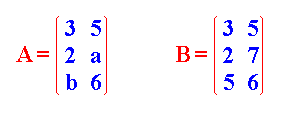MATRICES
Las matrices se utilizan para múltiples aplicaciones y sirven, en particular, para representar los coeficientes de los sistemas de ecuaciones lineales o para representar las aplicaciones lineales; en este último caso las matrices desempeñan el mismo papel que los datos de un vector para las aplicaciones lineales.
Pueden sumarse, multiplicarse y descomponerse de varias formas, lo que también las hace un concepto clave en el campo del álgebra lineal.
Ejemplo
Dada la matriz
 . La entrada
. La entrada  es 7.
es 7.La matriz

 : un vector fila con 9 entradas.
: un vector fila con 9 entradas.Suma o adición
Sean . Se define la operación de suma o adición de matrices como una operación binaria
. Se define la operación de suma o adición de matrices como una operación binaria  tal que
tal que  y donde
y donde  en el que la operación de suma en la última expresión es la operación binaria correspondiente pero en el campo
en el que la operación de suma en la última expresión es la operación binaria correspondiente pero en el campo  . Por ejemplo, la entrada
. Por ejemplo, la entrada  es igual a la suma de los elementos
es igual a la suma de los elementos  y
y  lo cual es
lo cual es  .
.Veamos un ejemplo más explícito. Sea


| IGUALDAD DE MATRICES | |
| Dos matrices son iguales cuando tienen la misma dimensión y los elementos que ocupan la misma posición en ambas son iguales | |
| Para que las matrices A y B sean iguales, se tiene que cumplir que a = 7 y b = 5. | |
TIPOS DE MATRICES
- Matriz Fila
- Matriz Columna
- Matriz Rectangular
- Matriz Transpuesta
- Matriz Nula
- Matriz Cuadrada
CLASES DE MATRICES CUADRADAS
- Matriz triangular superior
- Matriz triangular inferior
- Matriz diagonal
- Matriz escalar
- Matriz identidad o unidad
- Matriz regular
- Matriz singular
- Matriz idempotente
- Matriz involutiva
- Matriz simétrica
- Matriz antisimetrica o hemisimetrica
- Matriz ortogonal




No hay comentarios:
Publicar un comentario